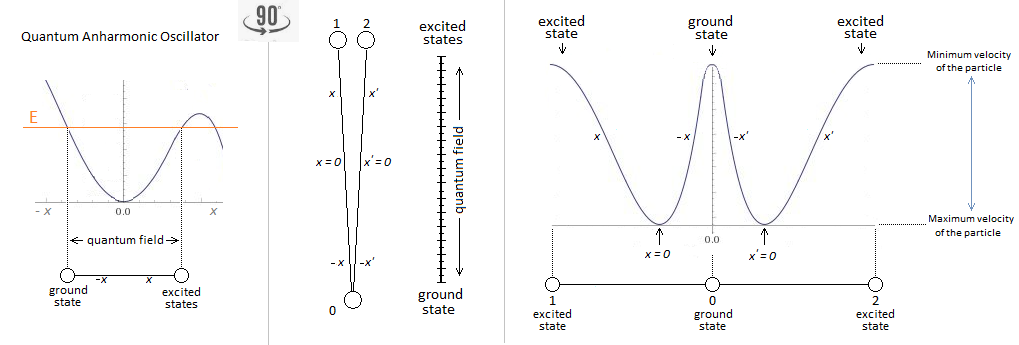-
Posts
569 -
Joined
-
Last visited
-
Days Won
1
Kartazion last won the day on September 16 2020
Kartazion had the most liked content!
Contact Methods
-
Website URL
https://www.kartazion.com
Profile Information
-
Location
France
-
Favorite Area of Science
Quantum Mechanics
Recent Profile Visitors
8542 profile views
Kartazion's Achievements

Molecule (6/13)
5
Reputation
-
Curvature occurs only by under the influence of mass or energy. Mass being that represented at rest in Figure 3 is then substituted by energy. The curvature is therefore produced by this energy distribution. For example for inflation similarities are to be noted between the shape of the charge/discharge curve of an RC circuit through Vc.
-
The ratio between the "impulssion energy" and the velocity of the particle gives the curvature by "?". Dark energy can maintain constant or accelerated kinetics. But in the fugure case presented the particle has reached the end of the expansion of the universe and falls back into a big-crunch.
-
Here in Figure 3 is an archaic representation, really very basic and non-operational yet, but which already gives an idea of how one could interpret the flow/flux of mass-energy equivalence related to the impulssion/momentum energy ; And integrated into the gravitational attraction. A clear distinction must be made between the mass-energy equivalence and the momentum energy given to the particle. The depletion of momentum energy occurs as the particle picks up speed. IOW the exhaustion of the energy of the impulssion is related (proportinnal?) to the speed of the particle. I have to complete the missing parameters. I'm working on it. Your help has been invaluable to me. I'm not sure I have correctly identified the problem in relation to the tool called energy–momentum tensor or else it represents a different vision. Figure 3.
-
Tweaking. Sorry. 'pofinage' was a French word. I wrote orthonormal and not orthogonal. A gravitational singularity is a region of spacetime in the vicinity of which certain quantities describing the gravitational field become infinite regardless of the coordinate system used. The Kerr metric is also a vacuum solution and describes a black hole and the shape of a ring can be called a ring singularity or ringularity. I corrected. Thanks. I don't want to be clumsy in my answer. But already the mass of the particle at rest located at the level of the singularity represents the total mass of the universe. I therefore let you imagine the amount of energy to be applied to the particle in order to be able to simulate inflation through an oscillating movement.
-
I don't know yet demonstrated a metric tensor. But the metric (maybe the term is badly chosen) in the proper sense of the term does not change the orthonormal basis. On the other hand, the interpretation of the curvature of space-time of the black hole is affected by the innovation that I support. To do this, and at first, a simple matrix can be used. But I haven't finished writing about it yet. I already have all the technical elements but the pofinage remains to be determined. This remains a complex subject in its interpretation of what is a space-time curvature from the inflation. In a second time the tensor will be able to generate the shape of our universe in its continuum, while the matrix will be the mechanism which constitutes it through the particle.
-
Yes of course. It corresponds to the particle at rest of an immeasurable value of its mass, and as well as the interpretation of the true vacuum in quantum field theory. Thereafter the extension of the particle is interpreted by the principle of mass-energy equivalence. The purpose of this experiment is to be able to precisely add the explanation of inflation up to the Friedmann-Robertson-Walker metric which is already very good one. The problem with Kerr–Newman metric is the consideration of symmetric entailment. But Newman found a way out with Axial symmetry. In this reference I base myself on an energy density of the particle as a convergent point thanks to the principle of mass-energy equivalence, until its rest: IOW Kerr-Newman metric describes a black hole solutions to the Einstein-Maxwell equations of general relativity. Very simply and for a black hole considering a potential energy and a kinetic energy of the particle by Hawking radiation determines the following clock Figure 2. Figure 2.
-
Hello. I indeed have a preference for the interpretation for Kerr–Newman metric which seems to me the one that comes closest to the gravitational singularity, because this metric includes the non-zero mass with a non-zero electric charge and an equally non-zero angular momentum. But I believe that its metric is limited to that of the black hole and does not assume the rest of the space-time to be studied. I will therefore open a new thread to explain if you will the metric which I think could elucidate the interpretation of the gravitational singularity of the big-bang type followed by its metric of expansion of the rest of the space-time of the universe . I don't know if I'm overdoing it but its name is Kartazion Metrics.
-
Hello. Here is a topic which is not one of the simplest. Here is the proposal for a new metric which has the principle of being able to take into account cosmic inflation in relation to the expansion of the universe. Indeed its mechanism is that of the interpretation and for a gravitational singularity of a single-particle entropic convergence. IOW what is defined as a singularity with infinite value would then only be an interpretation of a paricle at rest. The expansion of the particle from its singular point which expresses its rest will therefore propagate asymmetrically in space-time. At first, the entropy of a supermassive black hole is only the particle's alternation between singularity (singular point) and the galactic halo. When the correlated particle explained by chromodynamics, is expressed in mass, while its flow between singularity and correlated matter is expressed in energy by the prince of mass-energy equvalence (Figure 1). The next post will be fed with a more explicit explanation. Figure 1 Reference: [1] Kerr–Newman metric [2] Friedmann-Robertson-Walker
-
As you know I like to speak in pictures. Judging by my very first thread [1] on this form, here Figure 1 is how precisely the quasilocal mass is already an excellent visual approach to what I was saying previously. The second interpretation to be made and for the other part not understandable is simply appliclabe to the principle of the mass-energy equivalence. Figure 1. source: https://www.scirp.org/journal/paperinformation.aspx?paperid=116396 credit: https://orcid.org/0000-0001-7277-1654 [1] Yes yes. I understand where the community struggles to understand.
-
The fact that the gravitational waves are spiral indicates in one, that its propagation is asymmetric (outside the binary system), and in two that there is the possibility of being able to interpret the spiral propagation by an interpretation of a linear propagation mechanism (like a kind screw where its position on it is linear). But the more important is the interpretation of gravity as we know it, at the level of the observer, and in its "usual" interaction, acts as a vectorial action, and this attraction due to gravity is therefore perpendicular to the observer and this in relation to the ground i.e. here on Earth. IOW the radius whose source of gravity which is the emitter of it, crosses the gravitational wave by cutting it. I have a clear mechanical interpretation on this subject, but due to the rules of this forum I should open a new thread on it.
-
Ok. So what does this article brings to the understanding of the energies of the universe?
-
No it's not ambiguous. For example associate the linear displacement of the particle following the rotation of a clock which makes it possible to determine the position of the particle. In this example the direction stay the same and does not depend on the angle. IOW I find it logical and for angular rotation associated with the linear displacement of the particle, namely the speed of the particle according to the angular velocity to be able to determine its mass by mass-energy equivalence. A weak rotation of the angular velocity makes it possible to make move the particle radiatively or linearly in a form of classical interpretation of the mass, whereas a fast rotation determines a flow of it due to the principle of equivalence. Hence the angular momentum related to that of the mass of a black hole is fully justified.
-
I'm curious to know what the news is on this. If there is a source it is welcome.
-

Hypothesis about the formation of particles from fields
Kartazion replied to computer's topic in Speculations
It's something about Klein–Gordon equation. I thought it was used. Energy and flux is a scalar quantity. That's why I thought that. -

Hypothesis about the formation of particles from fields
Kartazion replied to computer's topic in Speculations
But the interpretation of the energy E is scalar through the stress-energy-momentum tensor. It's just for confirmation. Thanks.










